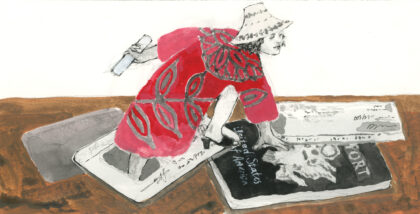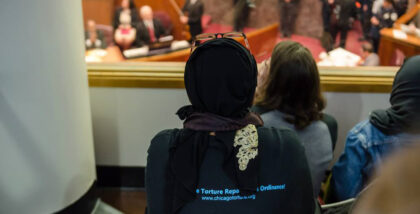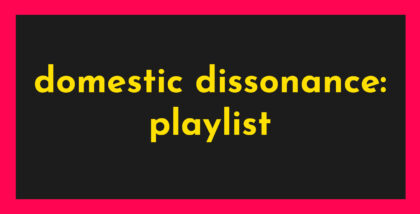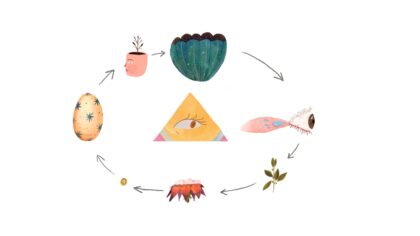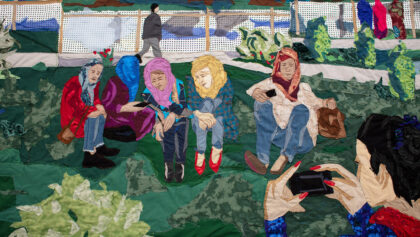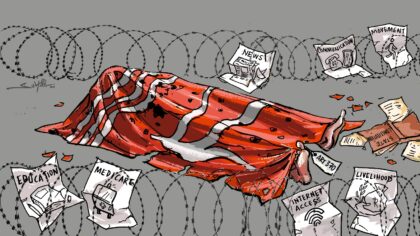 Illustration: Jia Sung
Illustration: Jia Sung
My mom was pregnant at 18, divorced at 22. Free again, or finally and at once, at 37. I grew up in California in the early ’80s in the time of single mothers. We were latchkey kids, or sometimes my mom would swap with another parent and agree to pick me and another kid up from school, but almost always was late, and would occasionally forget about us.
I thought I’d learned everything about life in those early years in the hours between school and when my mom came home. I’d learned that my job was to be inexpensive and out of the way. If I could choose one word to describe myself then, it’d be compliant. The way this looked was—no matter what I was doing, each night after school, when I heard those high heels making their way up the steps to our apartment, I’d stop and begin cleaning. I never knew which mood my mother would be in when she walked in the door, and I wanted to make room for the worst ones.
We were poor. When my mom was in a bad mood, she held on to me too tightly, with a vice grip, until a man came along. Then she’d disappear. The thing I most respect her for is how hard she worked. She raised me on her own. We had crummy roach-infested apartments. I wanted McDonald’s when we ate smoked oysters from the can. I was ashamed of our junk food and how poor we were. Later, I was placed in foster care, because of her abuse but also—I thought we’d failed each other in a way that maybe could have been solved with money.
*
In 1996, the year I was emancipated from the child welfare system, President Bill Clinton signed into law the Personal Responsibility and Work Opportunity Reconciliation Act, what we’ve come to know as “welfare reform.” It instituted a program called Temporary Assistance for Needy Families. The key word here is temporary. TANF set forth strict work requirements and restricted cash assistance to two consecutive years, with a five-year lifetime limit. It took the deep-set American idea that help renders people weak, that the poor should just pull themselves up by their bootstraps—and baked it into policy.
There’s a photo from that year of Clinton smiling, surrounded by other legislators, including a young Black woman standing to his left. She’s dressed in white, wearing pearls, and looking at the bill. On his right is another Black woman. She’s older, more mature, and sending the younger woman a Look. One that warned the building’s on fire.
That woman’s name is Lillie Harden, a 42-year-old single parent from Arkansas presented as Clinton’s welfare reform success story. Shortly before the bill signing, Harden stood at a podium against swaying American flags and talked about how she, a mother on welfare from North Little Rock, Arkansas, had benefited from getting off government assistance. She described pride in her family, crediting then-Governor Clinton’s welfare-to-work program for her well-being and her children’s accomplishments.
Yet the expression on Harden’s face seemed to tell a different story. I wonder if it was because Harden knew that welfare benefits weren’t extended to most poor Black women in the US until the 1960s—and that even as she stood on that podium, white women were routinely receiving more cash benefits than Black women. The conventional wisdom was that people felt Black women could make it on less money.
Part of this law was supposed to ensure that women would receive childcare while looking for work. Each state was given a block grant to implement this provision however they chose to in order to encourage women receiving financial assistance to get full-time employment. Predictably, execution was inconsistent across the country, and the path to work nowhere as smooth as anticipated. In the 15 years to come, America would see a rise in extreme poverty, with the number of households with children living on less than $2.00 per person per day growing by 159 percent.
In California, the place I’ve always called home, the failure to deliver on childcare assistance was particularly profound. The state’s 1997 welfare reform program, called CalWORKs, made a promise to families that affordable childcare would be available to keep their children safe and learning as parents gained the skills they needed and re-entered the workforce. But in the twenty years since CalWORKs was created, 300,000 children remained on waiting lists.
This idea became like Athenaeum, the infamous unfinished portrait of George Washington. The painter, Gilbert Stuart, intentionally left the piece incomplete, with a void at the bottom. This image, preserved on our dollar bills, has given us a memory of something that we’ve never fully seen.
Which brings me back to welfare reform. Similar to Washington and the painting, the law is one that has never been rendered to its true likeness. Perhaps intention was considered enough to create the impression that something had been done.
But that incompleteness has made space for a cold violence. A slow and meticulous breaking down of people. Exposing children to precariousness, depriving people of financial security, health benefits, affordable housing, safe working and living conditions. Deep and perpetual uncertainty. Welfare reform, with all its promises, failed to address any of these issues, and in some instances made things worse. This has been especially true for the most vulnerable, the children welfare was designed to protect in the first place. This cold violence is more pervasive, more accepted, than the sudden red-hot kind. But, like pouring water on a hot oil fire, together they grow.
Now, however, after two decades of this half-realized law, there’s a robust effort to improve it. Parents in California are spearheading a movement to demand more resources for childcare, and for childcare to begin sooner, as early as birth.
*
My own need and desire to be compliant only got further pronounced as I was shuffled from one foster home to another. I was not to take up any space in this world. I was to follow rules, and there were an abundance of them. Lights out. No Mom Talk. Clean my room. Make my bed. No cussing, curfew, no tagging, no stealing, no fighting. I did all those things, followed all those rules, and could do nothing more but dream of the world outside and around us without any rules.
There is something in the cold violence that strips us of this freedom to claim an internal life, to feel confident and loved.
I dreamed of friends, guys with tattoos and sagging pants, writing on the backs of buses with two-toned meanstreaks—wax markers sliced in half and rolled together to write in two colors. I yearned for raunchy places, the Motor Yards, where friends spray-painted along the train tracks, or underground clubs where guys and girls popped Ecstasy and danced around in ridiculous velvet hats and giant overalls.
Mostly I yearned for cafes in bookstores. Reading and writing and smoking cigarettes and not adhering to anyone’s idea of time. Allowing myself to reach deep down inside of my thoughts, beyond the place that was cold and shut down throughout the day, the Top Of The Mind preoccupied with counting and time and lists of rules to adhere to, finally transcended for the span of a couple mugs of coffee.
There is something in the cold violence that strips us of this freedom to claim an internal life, to feel confident and loved.
*
In May 2019, I went to a rally at California’s state capitol in Sacramento. I wanted to understand what exactly our state was willing to do to help families in need of childcare, and I also wanted to meet the people determined to shift our inadequate policies.
Gathered on the lawn in front of the capitol were 700 parents and children wearing blue T-shirts with big white block letters. There were banners and balloons. Off to the side of the front steps was a circus-style obstacle course. The group behind the rally, Parent Voices, hoped to convey to legislators the barriers families confront when navigating the complex childcare system—to make the decision-makers, quite literally, jump through hoops too. They called it the 2019 Stand for Children Olympics.
The California Budget and Policy Center finds an estimated two million children qualify for childcare assistance, but most do not receive it. Eighty-six percent of these children are of color. This hardship extends to their parents, whose work is constantly in flux due to inconsistent childcare options, and who also have to contend with record-high housing costs.
At the obstacle course, I met Kathleen Reed, a single mother of two toddlers who lives in Solano County, California. She’s a full-time student, part-time employee, and sole provider for her kids. Like my mother, she receives TANF to help make ends meet. But her experience reveals the absurdity of the system: she’s been able to get childcare, but only when it is approved and connected to a CalWORKs event. Meaning, if she is attending a class at the local social services office, no problem. But for job searching or actually going to work, she has to keep reapplying.
“You’d think that if they wanted us to work they would help us with childcare,” Kathleen told me. She has had to request 11 childcare approvals in the last 16 months. Her work schedule is erratic, sometimes late nights and sometimes weekends, and it has been hard to find providers who can commit to random days or times because she’s not able to offer them the security of approved and steady payment.
This reminded me of my time in foster care, the tedious ways in which I needed approval for everyday things. Bus tokens, lunch tickets, food at the grocery store, even medical appointments—back then each need was a transaction delivered and dealt in little slips of paper. Food stamps were actual scrips of paper, Medi-Cal was a sheet with stickers. Such was the currency of my life that miraculously stayed intact wherever I went, when placements could change as frequently as every six months.
*
According to a 2017 study from the Learning Policy Institute, California does not have sufficient funding to offer state-subsidized childcare to every family who is legally eligible. One of those mothers is Belia Rivas, who was also at the rally in Sacramento. Rivas lives in Fresno—farm country: dirt, heat, and raisins—with her four children between the ages of five and 15. Four years ago, she completed vocational training for web development and found part-time work. But when she sought childcare for her youngest kid, she was told her income was too high to continue to be eligible.
In practice, though, she couldn’t afford childcare. So she moved back home with her father, who watched her youngest daughter while she worked. She’s working part-time now and training to be a radiologist. Recently, she got approved for a section 8 housing voucher and was looking for an apartment for her family. She told me that minimum wage in Fresno is $12.00 an hour while a two-bedroom apartment in a decent neighborhood runs around $925.00 a month. She gets $308.00 a month from CalWORKs. Her boys’ father pays child support, but because she gets CalWORKS, the state only allows her to receive $50.00 of the support—the rest goes to the state to reimburse it for CalWORKs. Her next challenge will be to find childcare once she gets a steady job in radiology. She used to work the graveyard shift, and right now she doesn’t know of any approved facility that will provide 24-hour childcare.
Rivas’s balancing act made me think of my mother—we came to Los Angeles so she could attend UCLA. Sometimes a roommate would babysit me, or I’d go to school with mom. I spent my nights hanging out on campus or in the cafeteria. I liked going to school with her; I’d imagine I was a student. Sometimes she’d enroll me in a clinical trial on campus, or a study of gifted children, something to keep me occupied while she was in class. But as I got older she’d just leave me alone in our apartment. I learned how to make simple things, like sardines on toast. I’d lay on my cheap worn mattress, my hand slowly craning toward my face, trying to scare myself awake, the television and lights on. Eventually, I’d fall asleep.
*
When I talked with another childcare activist, Cindy Rodas, she started out reticent. “I don’t think my story has a lot of power,” she told me. She lives in San Rafael, California, which is mostly low-income, and three or four families to an apartment. Her husband didn’t want to live with anyone else, so her family of five is always struggling to pay the rent.
Her children are eight, five, and two years old, and childcare needs have hit her hardest this year. She graduated from high school and was taking college classes, but she could only do so when her husband wasn’t working. She ended up not being able to make it to most of her classes and not passing that first semester.
She’s struggled to get an answer from the Head Start daycare program after being on a waitlist for three years. Meanwhile, she’s been dealing with her middle son’s speech, language, and mobility issues and shuttling him around to various therapists. It has been difficult for him to stay engaged with the counselors and to get him to stop crying—he throws tantrums and can’t focus. “I was like—Am I being a bad mother? Is he doing what he’s supposed to be doing?
She said her biggest challenge is having a child identified with special needs. “He’s not ready for kindergarten. People ask me all the time—why didn’t you put him in school to interact with other children? But I don’t make enough money to pay tuition for a private school where he can interact with other children.”
“No public institution provides the hours I need. I do house cleaning. My last job I was told even if I had an emergency, you stay here or you get fired. So since then I’ve changed to work with a relative.”
“If I could have anything I want? I think I would ask for a better world for my kids—a better place for them to grow up. Lately I’ve been seeing so much hate.” She said people automatically take her for some sort of moocher, because she’s Latina, “even if you speak the best English in the world.”
Why are you asking for childcare? If you need childcare and you can’t pay for it—you shouldn’t have kids. That’s the way people treat me.
“Why are you asking for childcare? If you need childcare and you can’t pay for it—you shouldn’t have kids. That’s the way people treat me.”
“I’m not asking for free childcare, I’m asking to help us out. Help us to give something more. I want to bring something more to my family. I want to give them more than they deserve.”
*
About 40 percent of American children under five spend at least part of their week with somebody other than a parent. Many attend unregulated, affordable home daycares. In our “mixed economy” system, standards vary widely between private and publicly subsidized care; the quality of care a child receives is often linked to the socioeconomic status of the parents.
It’s a different story in many other countries. Across much of Western Europe, childcare is single-sector, heavily subsidized, and often provided and regulated by the central government. In countries like Denmark and Norway, the cost of care is determined by how much parents earn, and is capped at a certain percentage of the family income.
Most couples in the US spend around 25 percent of their income on childcare, and for single parents that doubles to about 53 percent. Compare that to Denmark, where couples spend about 11 percent of their income on childcare, and single parents no more than 2.9 percent.
But in the United States, childcare falls under the banner of that pervasive adage, “personal responsibility.” I’ve come to understand that in America we love the idea of ownership, not so much the act of owning but using words like “mine” and “yours.” We agree that only one person can say “mine” about any one thing and that the one who says “mine” about the greatest number of things, in this game of Capitalism, is the happiest. In this same sense, the president may call this land or the people in it his, even though there are parts of this land he has never set foot on and there are people to whom he’s done nothing but harm.
The powerful and influential spend billions building narratives and legislation to perpetuate the idea that says: whatever you’ve got going on is your problem. You have kids and you can’t afford childcare? Your problem. You don’t have a job? Your problem. You don’t have access to decent healthcare or education? Your problem. Call it alienation from our shared humanity, and disregard for the other, all wrapped up in warped notions of strength, of self-reliance, of individualism.
And so our nation’s policies are shaped in the image of this mindset, which requires the marginalized to remain marginalized, which values some children over others, which renders the chance to thrive conditional, a circumstance of birth. For example, babies of color, who comprise slightly more than half of all births, disproportionately lack the resources to flourish. Discriminatory policies mean children of color are more likely to be poor, be born to soon or too small, and live in unsafe environments—adversities that compound and thwart potential for a person’s whole life.
Despite the fact that work and what a family looks like has changed in the last several decades, the child support system hasn’t caught up. The overall perception is that children are solely the parents’ responsibility, and if there is inequity among the lives of parents… so be it. Another cold slap—placing the burden on the individual, shaming us for institutional failings, papering over structural inequality.
It seems the job of the child is to build dreams, but once you enter the system, you learn to live one approval or rejection from the state at a time.
I think what I grieved most in the foster care system was this sense of lost potential. It seems the job of the child is to build dreams, but once you enter the system, you learn to live one court date, one policy change, one approval or rejection from the state at a time.
*
Some of the girls in my group home yearned for their homegirls—other cholas who hung in the cuts, listening to oldies and smoking and drinking malt liquor. Some yearned for their man, sometimes a guy in juvie, who they dedicated sad songs to on the radio, and then some of them yearned for a better future, having given up on this present, this childhood that was no longer theirs, this childhood that ended one afternoon in Edelman Children’s court in Monterey Park. All they could do was hope that this second round would be better, because one of their wishes, something they’d yearned for previously, had already come true. They’d yearned for someone to love and now they were in the group home two, three, sometimes four months pregnant, getting ready to transfer somewhere else, to a place where single mothers go with babies.
We were all, every one of us, desperate to breathe in the world. To have sex and write our names on shit and eat our mother’s cooking, and get some kind of big dope recognition for something, to holler back at the world. On one side of the street the haves and the other the have-nots—the liquor stores, the motels, the recycling places—but then in foster care, we’d all be bobbing around together in the same house. A girl from Sherman Oaks, and a coke head from Beverly Hills, and a survivor of abuse from South LA, and we all maybe just wanted something from our grandmothers who wrote in that fancy cursive handwriting, and never saw the bad in us, and threatened a whooping, and prayed for us always, and the world was a changing ball of fire—but grandmas were the same.
*
Back in Sacramento, alongside the Stand Up For Children action, Governor Gavin Newsom announced that his budget proposal would increase spending for subsidized childcare programs, support training for the childcare workforce, improve and expand childcare options on college campuses, provide statewide full-day kindergarten, and expand home visiting programs with a specific funding stream aimed at improving infant and maternal health for African Americans. In a press conference, he detailed what he called his Parents Agenda. “The cost crisis is the foundational economic and quality of life challenge that California families face. As anyone who takes care of kids can tell you — these costs add up. From diapers to childcare, raising kids is expensive wherever you live. But when you factor in the cost of living here in California, it is close to impossible.” He thanked Parent Voices, and recognized that he in fact wasn’t able to give them everything that they wanted, but that it was an earnest start.
The scene, of Governor Newsom making this announcement, surrounded by boxes of diapers, reminded me of Clinton’s welfare reform press conference, and Lillie Harden at the podium, sharing how her children were enrolled in school and university, making good marks, all thanks to Clinton’s policies. Was Newsom doing right by these women, or was he hoping to score political points?
Harden’s own narrative helped legitimize, and sell, Clinton’s bill, but her story didn’t end there. 18 years later, Harden died. She had suffered a stroke earlier, and her income had left her in that middle space welfare reform exacerbated, unable to qualify for Medicaid and unable to afford the bill for her monthly prescriptions.
*
10 years ago—still struggling to get on my feet myself after a decade in foster care with inconsistent access to safety, school, and love—I was working at a transitional housing program for women who were chronically homeless. One day, I took one of the women to view the body of her dead baby in a mortuary. I picked her up in my 1980 Jeep Cherokee. It was a clunker, smelled of burnt caramel—you could drive it with a screwdriver and if the screwdriver slipped from the ignition the car would still drive. I lived in a rent-controlled apartment in a neighborhood in Los Angeles that was filled with jacaranda trees, so my car was covered in smushed flower guts. The woman, having grown up in the Cabrini Green projects in Chicago, looked at my car, saw the purple flowers, and said, “You must have a pretty life.” Which at the time, was far from true.
Notice that the parents I spoke with about childcare, none of them were asking to pass a specific bill, or to dedicate a certain amount of funding to the cause. “I would ask for a better world,” Cindy Rodas had told me. A world that just works. A world without racism and classism. A world where she could give her children more than they deserve. A pretty life.


